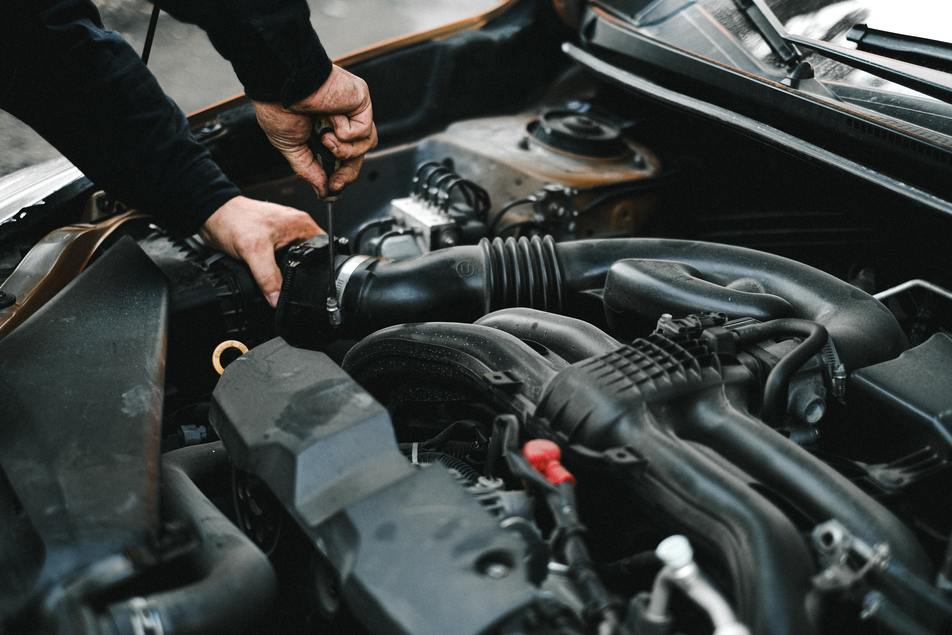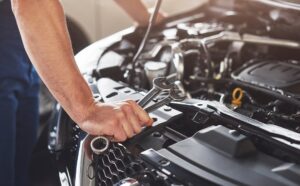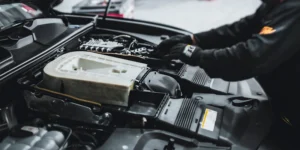Problems with a car’s engine can range greatly in how bad they are and how complicated they are, from small annoyances to major issues that need professional help. Here are some usual problems with car engines and some easy ways to fix them:
1. Check Engine Light Problem: The Check Engine Light (CEL) means there is a problem with the engine or the technology that controls emissions.
Fix:
Step 1: Look for a fuel cap that is loose or broken. Fix if it’s loose.
Step 2: Use a diagnostic tool to look for trouble codes in the car’s onboard diagnostic system (OBD-II). This might help you understand the problem better.
Step 3: Take care of any problems you find, like oxygen sensors, spark plugs, or mass airflow sensors that aren’t working right, based on the trouble codes. Get help from a professional if you need it.
2. Engine Misfires Problem: When an engine misfires, it idlings rough, doesn’t have enough power, or shakes while you’re moving.
Fix:
Step 1: Look for damage or wear in the spark plugs and ignition coils. What needs to be replaced.
Step 2: Check the ignition wires for damage and repair any that you find.
Step 3: Make sure the fuel injectors are clear by cleaning them or replacing them if they get stuck.
Step 4: Fix any vacuum leaks or broken sensors that might be affecting the mixing of air and fuel.
3. Overheating: The engine temperature gauge shows that the engine is too hot, or there is smoke or steam coming from the engine bay.
Fix:
Step 1: Stop in a safe place and turn off the engine right away to avoid damage.
Second, wait for the engine to cool down before you open the hood.
Step 3: Check the water level and add more if it’s low. Check the pipes, radiator, and water pump for leaks.
Step 4: Replace a broken thermostat that might be stuck shut, stopping the flow of water.
4. Knocking or Pinging Sounds from the Engine: The engine makes knocking or pinging sounds, especially when it’s under load or speeding up.
Fix:
Step 1: To cut down on pre-ignition and explosion, use fuel with a higher octane level.
2. Check the timing of the spark and make any necessary changes.
Step 3: If carbon buildup is causing noise, fix it in the combustion chambers or on the pistons.
5. Oil Leaks: There are oil spots or puddles under the car, and you can see oil leaks in the engine bay.
Fix:
Step 1: Look at the oil pan, seals, and covers to find where the leak is coming from.
Step 2: To stop more leaks, replace any seals or gaskets that are broken or old.
Step 3: Make sure the oil level and thickness are right to keep the engine running smoothly.
Trouble with Rough Idling: The engine runs unevenly or stops at rest.
Fix:
Step 1: If the idle air control valve (IACV) is jammed, clean it or get a new one.
Step 2: Check the throttle body and clean it to make sure airflow is smooth.
Step 3: Look for vacuum leaks and repair any hoses or gaskets that are worn out.
7. Less Power or Slower Acceleration: The engine doesn’t have enough power or is having trouble speeding up easily.
Fix:
Step 1: Make sure the airflow is good by checking for and replacing a clogged air filter.
Step 2: Check the fuel filters and change them if they are dirty or stuck.
Step 3: Clean or change the fuel injectors to make the oil flow better.
Step 4: If the car has turbochargers or superchargers, make sure they work properly.
8. Too Much Exhaust Smoke: Different problems are shown by blue, white, or black smoke from the exhaust.
Fix:
Check for oil leaks into the combustion area if you see blue smoke. Fix any engine rings or valve seals that are worn out.
If you see white smoke, check the coolant level and look for leaks into the cylinders. Take care of problems with the cooling system or head gasket.
Smoke Black: Make sure the air filter and entry system are not clogged. Take care of problems with the fuel injectors or too much fuel supply.
9. Engine Stalling Problem: The engine turns off by itself while the car is moving or just sitting there.
Fix:
Step 1: Look for an idle control valve that is dirty or broken. If you need to, clean or replace.
Step 2: Check and clean the throttle body to make sure air can flow properly.
Step 3: Check the fuel flow and how the fuel pump works. If you need to, replace.
Step 4: Fix problems with sensors that are affecting the timing of the engine or the supply of fuel.
10. Timing Belt or Chain Making Noise: The timing belt or chain is making noises like whining or grinding.
Fix:
Step 1: Look for cracks, wear, or slack in the timing belt or chain.
Step 2: Replace the timing belt as often as the maker says to (usually every 60,000 to 100,000 miles).
Step 3: If the noise is coming from the timing belt tensioners or guides, fix the problem.
In conclusion
Some problems with a car engine can be fixed with basic upkeep and troubleshooting, but others may need to be diagnosed and fixed by a professional. Regular maintenance, inspections at the right times, and taking care of problems right away can help keep your car running easily and avoid bigger problems. If you’re not sure what’s wrong or the problem is complicated, you should talk to an experienced mechanic or technician to get a correct diagnosis and repair.


